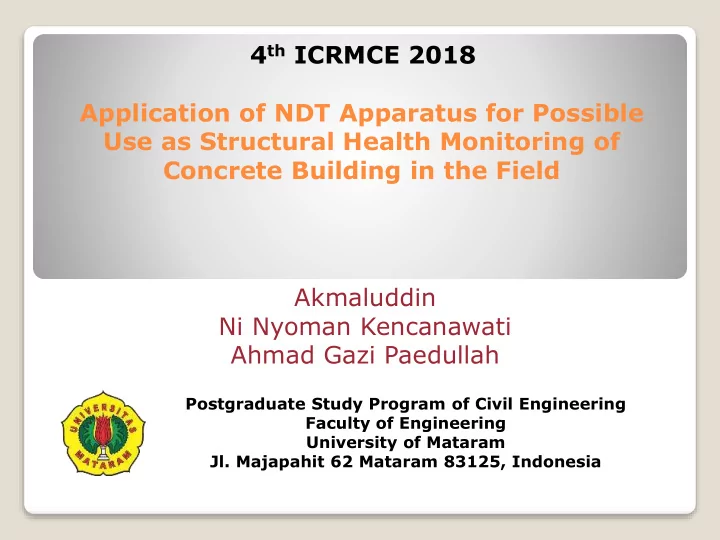

4 th ICRMCE 2018 Application of NDT Apparatus for Possible Use as Structural Health Monitoring of Concrete Building in the Field Akmaluddin Ni Nyoman Kencanawati Ahmad Gazi Paedullah Postgraduate Study Program of Civil Engineering Faculty of Engineering University of Mataram Jl. Majapahit 62 Mataram 83125, Indonesia
INTRODUCTION METHODOLOGY RESULTS AND DISCUSSION CONCLUSION OUTLINE
Introduction
Errors in the process of construction work due to low-quality control Extreme load on the building caused by natural disasters such as earthquakes; and Insufficient data for evaluating purposes if the building function is to be improved. Doubts arise about the ability of building’s serviceability a non-destructive test (NDT) on the existing building structure is required Background
This study is aimed to develop models for interpreting the residual strength of concrete structures in the field when the material quality and structural condition of the structure are questionable Objective
METHODOLOGY
2. Schmidt Hummer 1. Pundit plus Apparatus used
3. Flexural test equipment 4. Compression test equipment Apparatus used
Aggregates Description Course Sand aggregate Unit weight (gr/cm 3 ) 1341 1451 Bulk density (gr/cm 3 ) 1.520 1.646 Fineness modulus 3.203 6.67 Mud content (%) 3.06 - Specific gravity (SSD) 2.65 2.56 Material properties
Compressive strength (MPa) Description 25 35 45 Water to cement ratio 0.56 0.48 0.43 Cement (kg/m 3 ) 360 427 466 Water (kg/m 3 ) 205 205 205 Sand (kg/m 3 ) 740 713 693 Gravel (kg/m 3 ) 1110 1070 1040 Concrete mix proportions
Specimen Group Designation *) Objective number C-25 3 A preliminary test to develop the C-35 3 relationship between cylinder and C-45 3 1 cube specimen in terms of its Cu-25 3 mechanical properties Cu-35 3 Cu-45 3 Total 1 18 = (9 C and 9 Cu) Cu-25 3 2 Cu-35 3 Test UPV, Hammer, and DT Cu-45 3 Total 2 9 B-25 3 Real structure component 3 B-35 3 representation B-45 3 Total 3 9 Test specimens and schedule
(a) Details of specimens and testing
Testing activities
Testing activities (Structure representation)
RESULTS AND DISCUSSION
45000 50.00 40000 40.00 35000 f' c = 0.9313 f cu R² = 0.9527 30000 f' c (MPa) 30.00 E c (MPa) 25000 E c = 5341.8 √ f'c 20.00 20000 15000 10.00 10000 5000 0.00 0.00 20.00 40.00 60.00 0 0.00 2.00 4.00 6.00 8.00 f cu (MPa) √ f'c Compressive strength and elastic modulus
100 100 90 90 Cu-25 Cu-25 80 80 Cu-35 Cu-35 70 70 Cu-45 Cu-45 60 60 P (%) P (%) 50 50 40 40 30 30 20 20 10 10 0 0 0 1 2 3 4 5 10 15 20 25 30 35 40 45 v (km/s) R UPV and Rebound number
6 5 Linear 4 v = 0.1211 R relationship R² = 0.8636 v (km/s) v = 0.1211 R 3 2 1 0 0 10 20 30 40 50 R V – R relationship
Percentage load acting against v : different scanning method (left); direct method showing residual strength (right) P-v and RS-v relationsip
Direct method Indirect method 120 120 lower limit, lower limit, 90% confident 100 100 Excell Exc ent 80 80 Good upper lim RS (%) RS (%) Goo 60 60 90% confid d upper limit, Doubtf Doub 90% confid ul tful 40 40 Po Poor or 20 20 Very Very poor poor 0 0 0.0 1.0 2.0 3.0 4.0 5.0 0.0 1.0 2.0 3.0 4.0 5.0 v (km/s) v (km/s) Residual strength and concrete classification
Pulse velocity (km/s) Pulse velocity Residual Concrete (km/s) *) Direct method Indirect method strength, quality RS (%) v range v range v range (1) (2) (3) (4) (5) (6) (7) (8) excellent > 4.5 ~ > 4.4 ~ > 4.2 ~ > 80 good 3.5 – 4.5 1.0 3.7 – 4.4 0.7 3.6 – 4.1 0.5 60 - 80 doubtful 3.0 – 3.5 0.5 3.3 – 3.7 0.4 3.2 – 3.6 0.4 40 - 60 poor 2.0 – 3.0 1.0 2.9 – 3.3 0.4 2.8 – 3.2 0.4 20 - 40 very poor < 2.0 ~ < 2.9 ~ < 2.8 ~ < 20 *) Reference [10] Developing model: Concrete quality on the bases of pulse velocity
RS =47.82 v d -1.1 f c -79.699 RS =50.75 v i -0.899 f c -86.975 indirect method Direct method 75- 75- 100 100 50- 50- 75 75 25- 25- 100 100 50 50 75 75 RS (%) RS (%) 50 50 25 25 45 45 0 0 35 35 f'c f'c (MPa) (MPa) 25 25 v (km/s) v (km/s) Developing model in 3D plot
Midspan deflection (mm) 0 5 10 15 20 25 30 0 0 10 10 B-25 20 20 B-35 30 30 deflection limit to L/360 RS (%) B-45 RS (%) 40 40 50 50 UPV-25 60 60 UPV-35 70 70 UPV-45 80 80 90 90 100 100 0 2 4 6 v (km/s) Interpretation of beam condition (model validation)
Pulse velocity (km/s) Longitudinal Concrete pulse velocity Compressio quality/ Residual strength, RS Flexural test (km/s) *) n test structure (%) condition v v v (1) (2) (3) (4) (5) > 4.5 > 4.4 > 4.2 excellent > 80 3.5 – 4.5 3.7 – 4.4 3.5 – 4.1 good 60 - 80 *) Reference [10] Comparison of structure condition on the bases of pulse velocity with a different approach
The value of v is directly proportional to the load and inversely proportional to the residual strength. Concrete structures with a residual strength of more than 60% are considered healthy or in a structurally “good” condition . Also, the concrete structure is healthy when the v measured gives a value of 3.5 and above. This value is acceptable and lies within the v range of 3.5 – 4.5 given in the reference CONCLUSIONS
Thank you
Recommend
More recommend